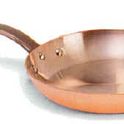What type of rice do you use in recipes like jambalaya long grain or quick rice? Do you cook if separate or beforehand?
20 Comments
SmaugApril 5, 2018
Jambalaya is traditionally made with long grain rice, it's nearest relative, paella, with short grain. Middle Eastern pilafs and similar Latin American dishes are made with long grain, risotto with short. I also remember reading about something called "broken rice" in connection with New Orleans cooking- it is long grain rice broken up into smaller pieces, imitating the starchiness and texture of short grain rices- never tried it. In all of these dishes the rice is cooked together with the other ingredients; not much of anyone uses quick rice.
sunyataApril 5, 2018
It was mentioned that K Paul's served the Jambalaya over the rice, that's now how he does it in this video:
https://www.youtube.com...
Another theory is that it came from Spanish settlers wanting Paella and the cooks using the locally available spices and ingredients. This supports the "rice in the pot" history which sounds right to me.
https://www.youtube.com...
Another theory is that it came from Spanish settlers wanting Paella and the cooks using the locally available spices and ingredients. This supports the "rice in the pot" history which sounds right to me.
Liz B.January 14, 2018
long grain if you want the jambalaya to come out with the great sticky quality it is known for!
pierinoJanuary 12, 2018
Believe me Cjr I have nothing but respect for the Acadian heritage and I do know quite a bit about the history which I have studied in depth. The historical origin of the name jambalaya is that it combines "jamon", French for ham with an African word "laya" meaning rice. The cooks in Creole kitchens were typically West African slaves. You are right about Spain being part of the larger picture. The history of Louisiana is unique in America. Cultures which were surpressed elsewhere have thrived in the Crescent City.
I am old enough to remember dining at Chez Helene as well as K Paul and the rice was always cooked separately. But perhaps that's the restaurant style. My cajun friend Steve Domingue does it that way in his restaurant too.
I am old enough to remember dining at Chez Helene as well as K Paul and the rice was always cooked separately. But perhaps that's the restaurant style. My cajun friend Steve Domingue does it that way in his restaurant too.
cjr4497January 12, 2018
mam, with all due respect i am just trying to tell you the truth. i am what you have studied from afar. i am here to tell you that is not correct.
what you ate all those years ago was not jambalaya and what your friends serves in his restaurant is not jambalaya if the rice is cooked on the side. if it is cooked on the side and mixed and allowed to settle for an hour then it is halfway correct. it still doesn't taste the same. if the meat and gravy mixture is served on top of rice then it is a simple rice-n-gravy, sauce piquante, creole, or an etoufee which are all other separate cajun/creole dishes. cooking the rice in the pot with the meat and gravy is the signature of the dish. anything else put in some book is wrong and anything else done by a supposed chef is wrong. there is no room for argument here. if your friend is from lafayette, then he knows he is not doing it right. he is afraid to screw it up and not have anything to serve. i don't blame him one bit.
what you ate all those years ago was not jambalaya and what your friends serves in his restaurant is not jambalaya if the rice is cooked on the side. if it is cooked on the side and mixed and allowed to settle for an hour then it is halfway correct. it still doesn't taste the same. if the meat and gravy mixture is served on top of rice then it is a simple rice-n-gravy, sauce piquante, creole, or an etoufee which are all other separate cajun/creole dishes. cooking the rice in the pot with the meat and gravy is the signature of the dish. anything else put in some book is wrong and anything else done by a supposed chef is wrong. there is no room for argument here. if your friend is from lafayette, then he knows he is not doing it right. he is afraid to screw it up and not have anything to serve. i don't blame him one bit.
TabithaLAugust 10, 2019
Jamon is Spanish for ham. Jambon is French for ham.
I am a south eastern Louisiana native. I have never, ever heard of jambalaya rice being cooked separately. It wouldn't be jambalaya. Period. There is no "alternate" way. I made jambalaya professionally for many local festivals. The rice is cooked with the meat and veg. End of story. Anyone who does it differently isn't making jambalaya.
I am a south eastern Louisiana native. I have never, ever heard of jambalaya rice being cooked separately. It wouldn't be jambalaya. Period. There is no "alternate" way. I made jambalaya professionally for many local festivals. The rice is cooked with the meat and veg. End of story. Anyone who does it differently isn't making jambalaya.
pierinoJanuary 12, 2018
Believe me Cjr I have nothing but respect for the Acadian heritage and I do know quite a bit about the history which I have studied in depth. The historical origin of the name jambalaya is that it combines "jamon", French for ham with an African word "laya" meaning rice. The cooks in Creole kitchens were typically West African slaves. You are right about Spain being part of the larger picture. The history of Louisiana is unique in America. Cultures which were surpressed elsewhere have thrived in the Crescent City.
I am old enough to remember dining at Chez Helene as well as K Paul and the rice was always cooked separately. But perhaps that's the restaurant style. My cajun friend Steve Domingue does it that way in his restaurant too.
I am old enough to remember dining at Chez Helene as well as K Paul and the rice was always cooked separately. But perhaps that's the restaurant style. My cajun friend Steve Domingue does it that way in his restaurant too.
cjr4497January 11, 2018
use regular long grain rice and cook it in the pot with the meat and gravy. it is not easy and takes some practice to get right. that is why so many people cook the rice on the side, but when you do that then it is not a true jambalaya anymore.
pierinoJanuary 12, 2018
Except that it's not a cajun dish, it's a creole one and in Louisiana that is an important distinction. The name combined French and African words for "ham" and "rice". In New Orleans they would not cook the rice in the jambalaya nor would they call it gravy.
pierinoJanuary 12, 2018
Except that it's not a cajun dish, it's a creole one and in Louisiana that is an important distinction. The name combined French and African words for "ham" and "rice". In New Orleans they would not cook the rice in the jambalaya nor would they call it gravy.
cjr4497January 12, 2018
pierino, i am sorry but that is simply not true. the rice is always cooked in the pot even in new orleans. to not cook it in the pot makes the dish something else. that is universal between cajun and creole versions of this dish. cooking the rice in the pot it is part of what the whole dish is about.
i am a cajun. i was born and have lived down here in acadiana my entire life. my culture is washing away, and i don't want my food's to wash away too. the rice is and always was cooked in the pot with the meat and the "broth" that we call gravy in new orleans and in cajun country.
if anyone out there is scared to cook the rice in the pot like many are, then you need to at least mix it in the pot with the meat and gravy and let is set for an hour or so to let the gravy soak into the rice. serving it over rice is like handing a man a fork with the teeth halfway mashed together and calling it a spoon. it is simply not done and called jambalaya.
also, the only real hardline difference between cajun and creole is the extra spices and tomato in creole food. that is not to say that cajuns didn't use tomato or some of the same herbs and spices on occasion. they were not always available and we just didn't use them in everything and to the degree that is often done in creole cooking. another difference is that cajun food from start to finish is done all in one pot. we don't do this and that in other pots then mix it together.
there are 2 theories on the word jambalaya that i have always been taught. 1 - boringly, the name is french and means mixing several things together. it used to be spelled jambalaia and changed somewhere along the way. 2- i have also heard that the name came from the Spanish screwing up an atakapa indian phrase about getting a full belly. i have never heard your version.
fyi - we have a strong spanish influence in all of our cooking as when we got kicked out of canada the spanish were already here and we blended our dishes together. lots of cajuns are dark complected. this comes from our mixing with the spanish and to a lesser degree, the american indians. a lot of our words are actually come from the various local indian tribes.
the traditional soup we cook down here came from the indians called hothe poni. it used meat, tomatoes and corn. we threw the trinity into that mix plus various beans, carrots, potatoes, and it became the cajun soup you will find cooking on stove tops all over acadiana when the temps dip into the 40's and below. you should try it.
i am a cajun. i was born and have lived down here in acadiana my entire life. my culture is washing away, and i don't want my food's to wash away too. the rice is and always was cooked in the pot with the meat and the "broth" that we call gravy in new orleans and in cajun country.
if anyone out there is scared to cook the rice in the pot like many are, then you need to at least mix it in the pot with the meat and gravy and let is set for an hour or so to let the gravy soak into the rice. serving it over rice is like handing a man a fork with the teeth halfway mashed together and calling it a spoon. it is simply not done and called jambalaya.
also, the only real hardline difference between cajun and creole is the extra spices and tomato in creole food. that is not to say that cajuns didn't use tomato or some of the same herbs and spices on occasion. they were not always available and we just didn't use them in everything and to the degree that is often done in creole cooking. another difference is that cajun food from start to finish is done all in one pot. we don't do this and that in other pots then mix it together.
there are 2 theories on the word jambalaya that i have always been taught. 1 - boringly, the name is french and means mixing several things together. it used to be spelled jambalaia and changed somewhere along the way. 2- i have also heard that the name came from the Spanish screwing up an atakapa indian phrase about getting a full belly. i have never heard your version.
fyi - we have a strong spanish influence in all of our cooking as when we got kicked out of canada the spanish were already here and we blended our dishes together. lots of cajuns are dark complected. this comes from our mixing with the spanish and to a lesser degree, the american indians. a lot of our words are actually come from the various local indian tribes.
the traditional soup we cook down here came from the indians called hothe poni. it used meat, tomatoes and corn. we threw the trinity into that mix plus various beans, carrots, potatoes, and it became the cajun soup you will find cooking on stove tops all over acadiana when the temps dip into the 40's and below. you should try it.
pierinoDecember 29, 2011
Yes, typically you would use long grain Carolina style white rice. And the jambalaya is indeed served over the cooked rice. And speaking of "evil" one of the worst atrocities I've ever seen on a chain restaurant menu was "Jambalaya pasta". The creole term "jambalaya" literally means ham and rice. The restaurant dish sounds about as exciting as a veggie burger.
Sam1148December 29, 2011
I"m changing my answer to this. While rice is sometime cooked with the Jambalaya . My personal preference is serving the mix over cooked rice, especially etouffees.
cjr4497January 11, 2018
pure cajun here, it is not jambalaya unless the rice is cooked in the pot with the meat and gravy. cooking the rice on the side and calling a dish jambalaya is considered unethical and will get you funny looks as soon as someone takes a taste. serving the meat and gravy on top of the rice takes it even further away from being jambalaya.
RobertaJDecember 29, 2011
Quick rice is evil. Never use it for anything you want to be proud of. As to whether or not in cooks in the jambalaya or not, look at your recipe. Some that I use (Paul Prudhomme's and John Besh's) cook it separately. Some cook it in the pot with the rest of the dish.
bigpanDecember 29, 2011
I've always used long grain domestic with no problems. I've never used a "quick" rice so can't comment. The key to a good jambalaya is the spices. I prefer use less heat and more spice so you can differentiate individual tastes. I also can recommend using premier Japanese rice as many now are grown in California.
Sam1148December 29, 2011
Depends on the recipe. Most NOLA recipes would mention 'rice' as uncooked by default unless specified. And they'd be talking about long grain rice..."Uncle Bens, Enriched rice" or "China Girl" brand. Not quick rice.
The amount of stock would clue you in...Think of it as a stock pot Paella with cajun seasonings.
The amount of stock would clue you in...Think of it as a stock pot Paella with cajun seasonings.
SlivyDecember 29, 2011
Thanks for the info. I just find that the rice does not cook all the way through and takes forever
Showing 20 out of 20 Comments
Recommended by Food52
Popular on Food52
Continue After Advertisement




